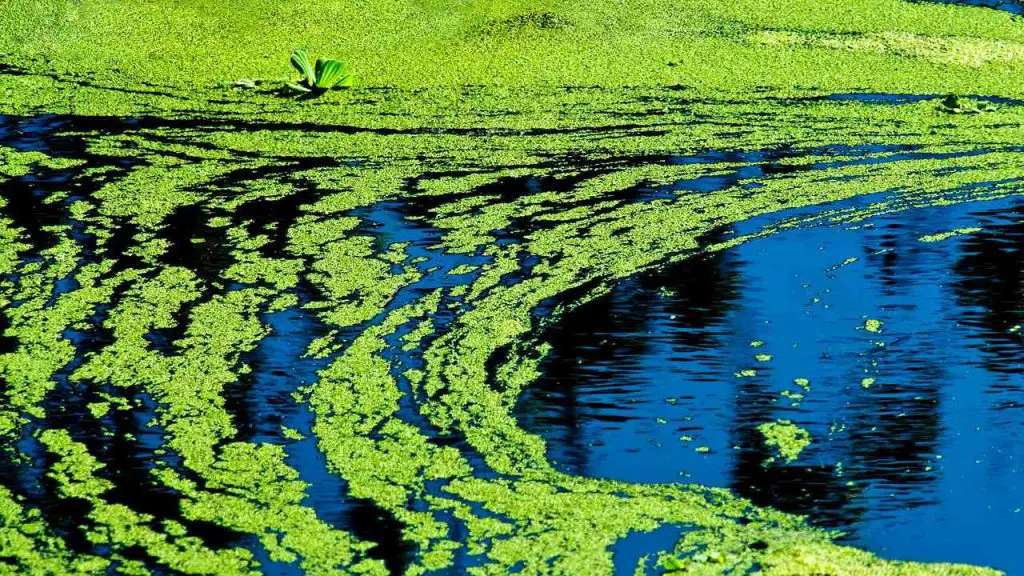Blue-green algae, also known as cyanobacteria, are a type of microorganism found in freshwater ponds and lakes. They are called “blue-green” because they contain chlorophyll, which gives them a blue-green color.
While they are a natural part of the ecosystem, they can become a problem when they grow out of control.
In small amounts, blue-green algae play an important role in the ecosystem, providing a food source for aquatic organisms and helping to oxygenate the water.
However, when they proliferate and grow excessively, they can create a thick, slimy layer on the surface of the water, which can make the pond or lake appear unsightly and uninviting.
In addition, high levels of blue-green algae can create a foul odor and make the water difficult to use for swimming, fishing, or other recreational activities.
It’s important to understand the causes, effects, and methods to control and prevent the growth of blue-green algae blooms in freshwater ponds and lakes.
This blog will provide an overview of the topic, including the role of blue-green algae in the ecosystem, the causes of their growth, methods of control and prevention, and the health concerns associated with blue-green algae blooms.
The role of blue-green algae in the ecosystem
Blue-green algae, also known as cyanobacteria, play a unique role in the ecosystem of freshwater ponds and lakes. They are a type of microorganism that is capable of performing photosynthesis, which means they can produce their own food by converting sunlight into energy.
This is the reason why they contain chlorophyll, which gives them their distinct blue-green color.
In small amounts, blue-green algae can be beneficial to the ecosystem, including:
- Providing a food source for aquatic organisms
- Helping to oxygenate the water
- Being a primary food source for certain types of zooplankton
- Producing oxygen as a byproduct of photosynthesis
However, when they proliferate and grow excessively, blue-green algae can cause a number of negative impacts on the ecosystem, such as:
- Creating a thick, slimy layer on the surface of the water
- Making the pond or lake appear unsightly and uninviting
- Creating a foul odor
- Making the water difficult to use for swimming, fishing, or other recreational activities
- Depleting the oxygen levels in the water, creating anoxic conditions
- Leading to fish kills and other negative impacts on the aquatic life
It’s important to note that:
- Overgrowth of blue-green algae can be an indication of larger environmental issues such as pollution
- Addressing the underlying issues can help prevent future blooms from occurring
- While they play an important role in the ecosystem, it’s important to keep their growth in check to maintain a healthy and safe environment for all aquatic organisms and humans.

Causes of blue-green algae growth
- One of the main reasons for the growth of blue-green algae is an excess of nutrients, such as phosphorus and nitrogen, in the water.
- These nutrients can come from agricultural runoff, sewage discharge, or other sources.
- When these nutrients are present in large quantities, they can cause the blue-green algae to grow rapidly and take over the pond or lake.
Control methods
- To control the growth of blue-green algae, it is important to reduce the number of nutrients in the water. This can be done by reducing the use of fertilizers, improving the treatment of sewage, and limiting the amount of animal waste that enters the water.
- In addition, regular monitoring of the water can help to identify when the levels of blue-green algae are becoming excessive.
- In some cases, it may be necessary to use chemicals to control the growth of blue-green algae. However, this should be done with caution, as the chemicals can also harm other aquatic organisms and may have negative effects on the overall health of the pond or lake.
Prevention methods
- To prevent blue-green algae blooms, it is important to reduce the sources of nutrients that can contribute to their growth. This can include:
- Properly managing agricultural practices, such as limiting the use of fertilizers and implementing measures to reduce runoff
- Improving sewage treatment and ensuring that any discharge is properly treated before entering the water
- Educating the community on the importance of proper household and pet waste disposal to avoid it entering the water.
- In addition, regular monitoring of the water can help to identify any potential issues before they become a problem. This includes monitoring water temperature, pH, and nutrient levels, as well as conducting regular visual inspections to look for signs of algae blooms.
Health concerns
- Blue-green algae blooms can also have health implications for humans and animals.
- When ingested or inhaled, some species of blue-green algae produce toxins that can cause serious health problems such as liver and nervous system damage.
- Swimming, fishing, or other recreational activities in water with blue-green algae blooms should be avoided, and pet owners should not let their pets drink or swim in water that contains it.
- People should contact their local health department or authorities if they suspect blue-green algae bloom.
Conclusion
In conclusion, blue-green algae blooms can be a major problem in freshwater ponds and lakes, causing unsightly conditions and potential health risks.
They can be detrimental to the overall health and appearance of the pond or lake, making it difficult for people to enjoy recreational activities or even making it unusable.
To prevent and control the growth of blue-green algae, it is important to understand the causes of their blooms and take the appropriate preventative and control measures.
Reducing the sources of nutrients that contribute to their growth, regular monitoring of water conditions, and taking steps to limit the number of pollutants entering the water can help to keep these blooms under control and maintain a healthy and safe environment.
Moreover, people should be aware of the potential health risks associated with blue-green algae blooms and take necessary precautions.
Swimming, fishing, or other recreational activities in water with blue-green algae blooms should be avoided, and pet owners should not let their pets drink or swim in water that contains it.
Additionally, people should contact their local health department or other authorities if they suspect blue-green algae bloom.
In summary, blue-green algae blooms are a significant problem that can be controlled and prevented with proper management and community awareness.
By understanding the causes and effects of these blooms, we can take steps to protect the health and beauty of our freshwater ponds and lakes for generations to come.
Recent Posts
